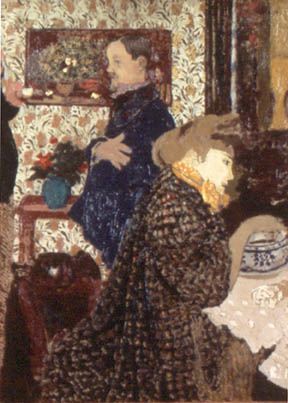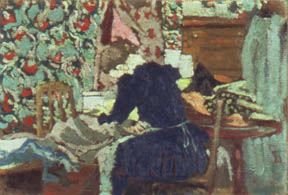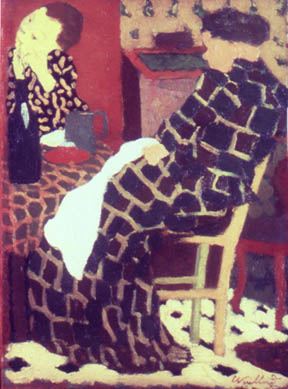Vuillard at the National Gallery of Art, Washington, DC
 "Misia and Vallotton at Villeneuve" (Oil on Board) 1899 |
By RAYMOND J. STEINER
March
2003
IF HE HAD been known primarily as the master of the "intimate scene," the current exhibit* at the National Gallery of Art in Washington, D.C. will certainly dispel any such limiting pigeon-holing of Edouard Vuillard in the future. A major retrospective of his oeuvre — some 330 works reproduced in the catalogue** (the numbers vary at each of the venues, some 230 paintings plus photographs, screens, prints, etc. at Washington) — the first since 1938 and the only viewing to be held in the United States, reveals an artist who is both prolific and versatile. Vuillard (1868—1940) spent most of his productive years in Paris, becoming a member of the Nabis shortly after his schooling, and though he abandoned his academic training through their influence, had largely gone his own way toward establishing his personally unique visual point of view. Much has already been written about Vuillard’s reserve and propriety and that, through living with his mother and sisters, he had developed what is most often referred to as his series of family "intimate scenes." Less well known is his extensive work in set-designs for the theatre, his intensely intellectual compositions, his landscapes, and his considerable reputation as a painter of portraits. Indeed, as this exhibit amply shows, Edouard Vuillard was a tireless experimenter and, personal gravity notwithstanding, somewhat of a sensualist in his lavish use of color and decorative design. It is always a danger to attempt to arrive at a valid characterization of an artist through his (or her) work, and that seems especially the case with Vuillard. What one may safely say, however, is that he was the quintessential painter, pushing many of the latest ideas of his time to their very limits in his work. As quiet and reserved as he may have been, he spent much of his time in and around Paris seeking visual stimulation and, from his many friends and acquaintances, new ideas about art, society, and politics. In art, he was not loathe to experiment, becoming one of the first to fully explore the distinctive qualities of distemper, developing along the way an exquisite sense of design and a free use of color — always, however, avoiding a clash of vision and technique, making each of his paintings an harmonious union of all its painterly and intellectual elements.
 "Interior" (Marie Leaning over her Work" (Oil on Board) 1892-93 |
Committed to the modernist dictum to honor the picture plane, Vuillard was skilled at suggesting depth and form through a highly sensitive use of color and a skillful manipulation of painted texture and decorative detail. His paintings are densely realized, his use of detail almost suffocating at times, yet always "readable," his images often ambiguous and stylized but ultimately comprehensible. He seems, at times, to think his pictures out rather than to paint them — that they are, in brief, intellectually rather than visually realized expressions. Returning once again to his family scenes of "intimacy," a close examination reveals them to be carefully staged "sets" rather than "spontaneous" vignettes of private life — as if Vuillard had taken what he had learned from the theatre and had applied it to his art. Combined with his knowledge of Japanese prints, of the growing body of knowledge concerning color theory, of the increasing tendency away from figurative art toward pure abstraction, of photography, and of the use of symbolism, Vuillard’s range of interest and sensitivity almost make it inevitable that his pictures are never static, never formalistic in their execution. Since this will be its only venue in the United States, this is an exhibit that you may not want to miss since it not only offers a fuller understanding and appreciation of Edouard Vuillard, but also goes a long way towards filling in the gaps of the uneven course of modernism in Western art.
 "Mother and Daughter at the Table" (Oil on Panel) 1891-92 |
*"Edouard Vuillard" (thru Apr 20): National Gallery of Art, 4th St. at Constitution Ave. NW, Washington, D.C. After closing in Washington, D.C., the show will travel to The Montreal Museum of Fine Arts (15 May—24 Aug); the Galeries nationales du Grand Palais, Paris (23 Sep—4 Jan ’04); and close at the Royal Academy of Arts, London (31 Jan—18 Apr ’04).
*A fully-illustrated catalogue accompanies the exhibition: 528 pp.; 9 3/4 x 12 3/4; 558 Illus., 463 in Color; List of Exhibitions; List of Illustrations; Index. $65.00 Hardcover. Yale University Press.